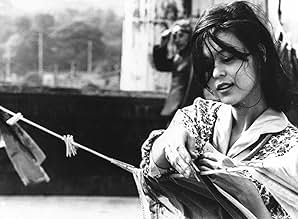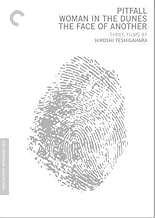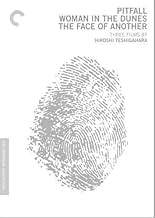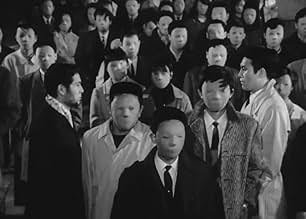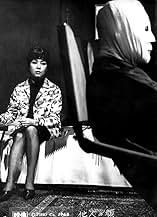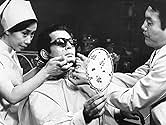IMDb रेटिंग
7.8/10
11 हज़ार
आपकी रेटिंग
अपनी भाषा में प्लॉट जोड़ेंA businessman with a disfigured face obtains a lifelike mask from his doctor, but the mask starts altering his personality.A businessman with a disfigured face obtains a lifelike mask from his doctor, but the mask starts altering his personality.A businessman with a disfigured face obtains a lifelike mask from his doctor, but the mask starts altering his personality.
- पुरस्कार
- कुल 2 जीत
Robert Dunham
- Foreign man in Bar
- (बिना क्रेडिट के)
फ़ीचर्ड समीक्षाएं
An accident at work has taken place, the result means you are left, without a face, only bandages for cover, they envelope and they smother, your existence now in limbo, an unfilled space. An opportunity arises to evolve, to put the past behind, to be absolved, present with a new profile, posturing with a new style, a future about which, you can revolve.
A fascinating piece of film making that has many layers and interpretations. For me, I see Mr. Okuyama representing post war Japan, the accident that removes his features the raw wound of two atomic bombs, the bandages a place to hide while the country considers its future and the new face, the new Japan, that finds a way to integrate itself into a modern world, while holding on to traditions and cultures that take a little more time to retune as the situation clarifies. Any film with Machiko Kyô performing is always a bonus too.
A fascinating piece of film making that has many layers and interpretations. For me, I see Mr. Okuyama representing post war Japan, the accident that removes his features the raw wound of two atomic bombs, the bandages a place to hide while the country considers its future and the new face, the new Japan, that finds a way to integrate itself into a modern world, while holding on to traditions and cultures that take a little more time to retune as the situation clarifies. Any film with Machiko Kyô performing is always a bonus too.
Mr. Okuyama (Tatsuya Nakadai) is a physically and emotionally wounded man. After an industrial accident at work, his face has been scarred and mutilated beyond recognition, and even his wife rejects him, even though she says his physical appearance doesn't matter. It has left him bitter and angry, until his psychiatrist Dr. Hira (Mikijiro Hira) comes up with a way to fashion a 'face mask' that will give him the appearance of having a completely normal face, albeit with a few joining marks. Hira doesn't do this just out of kindness, he is fascinated how this new face will alter Okuyama's personality and way of life.
The Face of Another is a fascinating film that highlights the social attitudes to physical appearance. There are hundreds of films and morality tales that teach you that it is inner beauty that counts, and once you allow this to shine then your physical attractiveness becomes irrelevant. Everyone knows that this is bullshit, so its refreshing to see a film that makes it clear from the outset that physical appearance has a massive part to play in society. Okuyama's new face, which is an attractive one, changes him so much that he takes on an almost dual identity. Dr. Hira delights in telling him that he has bought flashy new clothes, something he was never concerned with before. It becomes clear that whilst before Okuyama merely wanted to be normal again and fit back in society, his new face is engulfing him, and to be 'normal' simply isn't enough anymore.
As with many of the Japanese New Wave film-makers of the 1960's-70's, director Hiroshi Teshigahara takes some bold steps and sneaks in some surrealist and art-house values in a movie that is otherwise played relatively straight. A 'fictional' character appears every now and then throughout (she is first imagined by Okuyama's wife as a character in a movie); one side of her face is scarred and burned. She appears quite rarely, but seems to serve as an alternative to Okuyama's increasingly vain soul. Another scene seems a ball of hair that floats in the air, unnoticed by the people in the laboratory. I have no idea what it meant, and couldn't really admit to it being wholly successful, but it certainly got my attention nonetheless.
A powerful, disturbing, and poignant drama/horror from the greatest era in Japanese cinema. The film seems all the more important now, 45 years on, in a world where a botox injection can be as easy as buying a pack of cigarettes, and where physical 'beauty' is less a bonus than a necessity.
www.the-wrath-of-blog.blogspot.com
The Face of Another is a fascinating film that highlights the social attitudes to physical appearance. There are hundreds of films and morality tales that teach you that it is inner beauty that counts, and once you allow this to shine then your physical attractiveness becomes irrelevant. Everyone knows that this is bullshit, so its refreshing to see a film that makes it clear from the outset that physical appearance has a massive part to play in society. Okuyama's new face, which is an attractive one, changes him so much that he takes on an almost dual identity. Dr. Hira delights in telling him that he has bought flashy new clothes, something he was never concerned with before. It becomes clear that whilst before Okuyama merely wanted to be normal again and fit back in society, his new face is engulfing him, and to be 'normal' simply isn't enough anymore.
As with many of the Japanese New Wave film-makers of the 1960's-70's, director Hiroshi Teshigahara takes some bold steps and sneaks in some surrealist and art-house values in a movie that is otherwise played relatively straight. A 'fictional' character appears every now and then throughout (she is first imagined by Okuyama's wife as a character in a movie); one side of her face is scarred and burned. She appears quite rarely, but seems to serve as an alternative to Okuyama's increasingly vain soul. Another scene seems a ball of hair that floats in the air, unnoticed by the people in the laboratory. I have no idea what it meant, and couldn't really admit to it being wholly successful, but it certainly got my attention nonetheless.
A powerful, disturbing, and poignant drama/horror from the greatest era in Japanese cinema. The film seems all the more important now, 45 years on, in a world where a botox injection can be as easy as buying a pack of cigarettes, and where physical 'beauty' is less a bonus than a necessity.
www.the-wrath-of-blog.blogspot.com
Mr. Okuyama is involved in an accident at work which melts off his face and this understandably is constantly nagging him. This makes a mark on the relationship with his wife as he talks out at her about how miserable he is and what a monster he has become. He then talks his psychiatrist into making him a new face (which was quite easily done since the psychiatrist has had these kind of thoughts before) and he then goes on 'vacation'.
This is so excellent in every way. It is not a sci-fi movie, but in feel it sometimes comes close to. The images are quite surreal at times, the music is out of this world and some of the sets are not to be found in real life.
The editing is masterfully done, switching between main story and a parallel story about a girl with a similar problem, as well as switching between hand-held camera (not too shaky though), still pictures and still standing camera. The pictures of Segawa Hiroshi fits 35mm nicely, sometimes manipulating the background like I haven't seen before for example when the psychiatrist and Mr. Okayama is talking at the club and the crowd behind get 'invisible' by lighting.
Kyou Machiko did a terrific job in Ozu's 'Ukigusa' and likewise here. Too bad we don't see that much of her. Nakudai Tatsuya plays well as the mask. I don't know exactly what was special effects and not, but it was hard to tell.
Author and writer of screenplay Abe Koubou, director Teshigahara Hiroshi and Takemitsu Touru was behind another favourite of mine; 'Suna no Onna'. They also made 'Moetsukita Chizu' and I cant wait to get my hands on it!!
This is so excellent in every way. It is not a sci-fi movie, but in feel it sometimes comes close to. The images are quite surreal at times, the music is out of this world and some of the sets are not to be found in real life.
The editing is masterfully done, switching between main story and a parallel story about a girl with a similar problem, as well as switching between hand-held camera (not too shaky though), still pictures and still standing camera. The pictures of Segawa Hiroshi fits 35mm nicely, sometimes manipulating the background like I haven't seen before for example when the psychiatrist and Mr. Okayama is talking at the club and the crowd behind get 'invisible' by lighting.
Kyou Machiko did a terrific job in Ozu's 'Ukigusa' and likewise here. Too bad we don't see that much of her. Nakudai Tatsuya plays well as the mask. I don't know exactly what was special effects and not, but it was hard to tell.
Author and writer of screenplay Abe Koubou, director Teshigahara Hiroshi and Takemitsu Touru was behind another favourite of mine; 'Suna no Onna'. They also made 'Moetsukita Chizu' and I cant wait to get my hands on it!!
10Prion
This is a film that has to be rescued for all moviegoers.
I saw "The Face of Another" (Tanin no kao) at the National Gallery of Art's series, "A New Wave in Japan: 1955-1974," and was mesmerized by this "elegantly spooky and enigmatic examination of identity." This is the third of four Hiroshi Teshigahara (director)/Kobo Abe (writer)/ Toru Takemistu (composer) collaborations. They have reached nearly the same perfection in the fusion of image, sound, and subject in this work as in their brilliant work, "Woman in the Dunes."
A businessman (Tatsuya Nakadai), whose face has been scarred in an industrial fire, is receiving psychotherapy from a psychiatrist (Mikijiro Hira). He succeeds in persuading the psychiatrist to make a mask for him, amazingly lifelike but completely different from his own face. Soon after being fitted for the mask, he tries to seduce his wife (Machiko Kyo) and succeeds; she promptly falls for the handsome stranger. He becomes angry at her weakness for a handsome man, but she claims she was aware all along that he was her husband and believed that both were just masquerading together as most couples usually do in different ways. She tells him that it is not she but he who has worried excessively about his appearance and who has spoiled his relationship with others. Strangely enough, his personality seemingly begins to change after he puts on the mask as if the mask has influenced his personality. And, he comes to realize that his new identity does not enable him to reintegrate into society after all.
The film also has a touching subplot. A good-natured young woman (Miki Irie, now Mrs. Seiji Ozawa), the left side of whose face is beautiful, but the right side of which is disfigured, has been hurt by others' inquisitive eyes and insults. She has been shunned and never been treated as a lady by any man other than her older brother. One day, she and her brother take a trip to a seaside resort, and in the hotel, she asks him to make love to her, hiding from him the intention of killing herself the next morning. He accepts her surprising request. During the lovemaking, he kisses her on the right side of her face. Her brother is the only man who can understand her pain and solitude and who can love the ugliest part of her appearance because of his deep love for her.
After seeing this film, questions arise. What is Identity? How is it established? What is the relationship among Identity, Personality, and Physical Appearance? Does Personality determine Physical Appearance? Or, does Physical Appearance determine Personality? Abe and Teshigahara seem to challenge our common beliefs about this.
The story is easy to follow, unlike "Woman in the Dunes." The dialogue is sophisticated enough as to be quotable.
Takemitsu's musical score is outstanding. He has created a sharp contrast between sweet, sad music, which represents dance music for the masquerade, and deep, eerie "music," which represents the reality of faceless people.
I hope this film will enjoy a revival and come to video or DVD in the near future.
I saw "The Face of Another" (Tanin no kao) at the National Gallery of Art's series, "A New Wave in Japan: 1955-1974," and was mesmerized by this "elegantly spooky and enigmatic examination of identity." This is the third of four Hiroshi Teshigahara (director)/Kobo Abe (writer)/ Toru Takemistu (composer) collaborations. They have reached nearly the same perfection in the fusion of image, sound, and subject in this work as in their brilliant work, "Woman in the Dunes."
A businessman (Tatsuya Nakadai), whose face has been scarred in an industrial fire, is receiving psychotherapy from a psychiatrist (Mikijiro Hira). He succeeds in persuading the psychiatrist to make a mask for him, amazingly lifelike but completely different from his own face. Soon after being fitted for the mask, he tries to seduce his wife (Machiko Kyo) and succeeds; she promptly falls for the handsome stranger. He becomes angry at her weakness for a handsome man, but she claims she was aware all along that he was her husband and believed that both were just masquerading together as most couples usually do in different ways. She tells him that it is not she but he who has worried excessively about his appearance and who has spoiled his relationship with others. Strangely enough, his personality seemingly begins to change after he puts on the mask as if the mask has influenced his personality. And, he comes to realize that his new identity does not enable him to reintegrate into society after all.
The film also has a touching subplot. A good-natured young woman (Miki Irie, now Mrs. Seiji Ozawa), the left side of whose face is beautiful, but the right side of which is disfigured, has been hurt by others' inquisitive eyes and insults. She has been shunned and never been treated as a lady by any man other than her older brother. One day, she and her brother take a trip to a seaside resort, and in the hotel, she asks him to make love to her, hiding from him the intention of killing herself the next morning. He accepts her surprising request. During the lovemaking, he kisses her on the right side of her face. Her brother is the only man who can understand her pain and solitude and who can love the ugliest part of her appearance because of his deep love for her.
After seeing this film, questions arise. What is Identity? How is it established? What is the relationship among Identity, Personality, and Physical Appearance? Does Personality determine Physical Appearance? Or, does Physical Appearance determine Personality? Abe and Teshigahara seem to challenge our common beliefs about this.
The story is easy to follow, unlike "Woman in the Dunes." The dialogue is sophisticated enough as to be quotable.
Takemitsu's musical score is outstanding. He has created a sharp contrast between sweet, sad music, which represents dance music for the masquerade, and deep, eerie "music," which represents the reality of faceless people.
I hope this film will enjoy a revival and come to video or DVD in the near future.
James Quandt's strident narration of the "video essay" that accompanies the Criterion release of THE FACE OF ANOTHER complains about the reception the film received in the United States on its initial release. He quotes the critics of the time: "extravagantly chic," "arch," "abstruse," "hermetic," "slavishly symbolic," and "more grotesque than emotionally compelling." Stop right there! These critics knew what they were talking about.
The film combines several hoary and not particularly profound narrative contrivances. Here's a man attempting to seduce his wife, pretending to be another person--this was old when THE GUARDSMAN first went on stage and has been done countless times. Then there's the classic mad scientist, presented with very little nuance, delving into Things that Man Was Not Meant to Know. Related to this is that the story is only able to exist by grossly underestimating man's ability to adapt to the unknown. (An example is the 1952 science fiction story "Mother" by Alfred Coppel in which astronauts all return insane when confronted with the vastness of space.) These primitive tropes are shamelessly built on a simple narrative situation that is completely unable to carry them: a man with a disfigured face getting facial reconstruction. This happens all the time, so what's to "not meant to know"? If all this isn't enough, Teshigahara tacks on an unrelated, completely separate set of characters in their own undeveloped narrative that even Quandt thinks doesn't work. The dialogue by author/screenwriter Kobo Abe is risible, sounding like something out of a grade-B forties horror film.
To disguise the paucity of the film's narrative, Teshigahara has tricked it up with what Quandt admiringly calls "its arsenal of visual innovation: freeze-frames, defamiliarizing close-ups, wild zooms, wash-away wipes, X-rayed imagery, stuttered editing, surrealist tropes, swish pans, jump cuts, rear projection, montaged stills, edge framing, and canted, fragmented, and otherwise stylized compositions." These arty-farty gimmicks (and more) are, of course, hardly "innovations." They were endemic in the early sixties. Their extensive use seems a vain attempt to disguise the film's shallow content. Quandt also sees great significance in the many repetitions in the film: I see only repetition.
But even that is not the film's worst problem. Teshigahara often seems like a still photographer lost in a form that requires narrative structure. His inability to develop a sustained narrative makes the film seem far longer than its already-long two hours plus. Things happen, but the film doesn't really progress. The end result is little more than a compendium of tricks and narrative scraps borrowed from others.
The film combines several hoary and not particularly profound narrative contrivances. Here's a man attempting to seduce his wife, pretending to be another person--this was old when THE GUARDSMAN first went on stage and has been done countless times. Then there's the classic mad scientist, presented with very little nuance, delving into Things that Man Was Not Meant to Know. Related to this is that the story is only able to exist by grossly underestimating man's ability to adapt to the unknown. (An example is the 1952 science fiction story "Mother" by Alfred Coppel in which astronauts all return insane when confronted with the vastness of space.) These primitive tropes are shamelessly built on a simple narrative situation that is completely unable to carry them: a man with a disfigured face getting facial reconstruction. This happens all the time, so what's to "not meant to know"? If all this isn't enough, Teshigahara tacks on an unrelated, completely separate set of characters in their own undeveloped narrative that even Quandt thinks doesn't work. The dialogue by author/screenwriter Kobo Abe is risible, sounding like something out of a grade-B forties horror film.
To disguise the paucity of the film's narrative, Teshigahara has tricked it up with what Quandt admiringly calls "its arsenal of visual innovation: freeze-frames, defamiliarizing close-ups, wild zooms, wash-away wipes, X-rayed imagery, stuttered editing, surrealist tropes, swish pans, jump cuts, rear projection, montaged stills, edge framing, and canted, fragmented, and otherwise stylized compositions." These arty-farty gimmicks (and more) are, of course, hardly "innovations." They were endemic in the early sixties. Their extensive use seems a vain attempt to disguise the film's shallow content. Quandt also sees great significance in the many repetitions in the film: I see only repetition.
But even that is not the film's worst problem. Teshigahara often seems like a still photographer lost in a form that requires narrative structure. His inability to develop a sustained narrative makes the film seem far longer than its already-long two hours plus. Things happen, but the film doesn't really progress. The end result is little more than a compendium of tricks and narrative scraps borrowed from others.
क्या आपको पता है
- ट्रिवियाDirector Hiroshi Teshigahara said that he intended the film to explore both personal and cultural identities. While the examination of personal identity is quite overt, Teshigahara also explored how Japan's cultural identity had been impacted by World War II and its aftermath.
- भाव
Psychiatrist: You're not the only lonely man. Being free always involves being lonely. Just there is a mask you can peel off and another you can not.
- कनेक्शनReferenced in Bara no sôretsu (1969)
टॉप पसंद
रेटिंग देने के लिए साइन-इन करें और वैयक्तिकृत सुझावों के लिए वॉचलिस्ट करें
- How long is The Face of Another?Alexa द्वारा संचालित
विवरण
बॉक्स ऑफ़िस
- दुनिया भर में सकल
- $35,185
- चलने की अवधि2 घंटे 2 मिनट
- रंग
- ध्वनि मिश्रण
- पक्ष अनुपात
- 1.33 : 1
इस पेज में योगदान दें
किसी बदलाव का सुझाव दें या अनुपलब्ध कॉन्टेंट जोड़ें



